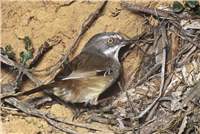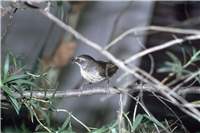Family
Pardalotidae
Genus
Sericornis
Species
frontalis
Threats/Control Methods - Regional
Land clearing, urban sprawl, grazing and the general tidiness of many gardens within the suburbs are all contributing to the declining availability of ideal habitat.
Threats/Control Methods - Local
Domestic pets deter this species from the suburbs.
Local/Urban Actions
Gardeners in the Canberra region with more natural, untamed backyard settings are more likely to provide a good environment with food and shelter for this species. Cat owners can prevent their pets preying on the species by creating a stimulating indoor environment and by installing a cat run or enclosure.
Common Names
White-browed Scrubwren, Spotted Scrubwren
Distinguishing Features
White-browed Scrubwrens are 11-14cm in size, with a pale eye, white eyebrow and white stripe below the eye. Upper parts of the body are coloured a dark olive-brown, while the throat is white with faint white streaks. The shoulder feathers are dark with small white marks. The female is greyer than the male, especially in the face and the young are greyer and duller.
Survey Techniques
Call and visual identification.
Species Call
A persistent 'ts-cheer' of harsh, scolding notes.
Similar Species
Other Scrubwrens are found across Australia, with paler faces and different coloured eyes. The White-browed is the only Canberra species, sharing a preferred habitat with the Superb Fairy-wren (Malurus cyaneus ).
Distribution
The White-browed Scrubwren are found along a broad coastal band from North QLD to Central WA and in TAS.
Country of Origin
Australia
Conservation (Pet/Pest) Status - Regional
The numbers have increased dramatically over the past 20 years (COG).
Conservation (Pet/Pest) Status - National
Secure, not listed under the EPBC Act 1999.
LSCCES Population
Numbers were highest at the ANBG, while none were recorded in Turner or Civic West.
Associated vegetation community
Across Australia, the White-browed Scrubwren can be found in any rainforest, open forest, woodland and heath with undergrowth. In Canberra, they survive in garden or heath areas with dense ground vegetation for shelter and protection.
Limiting Resources
This species depends on a messy ground layer of leaf litter, twigs and other undergrowth for foraging. It also prefers moist environments.
Breeding
Most nesting activity in Canberra takes place from early August to late October, with dependant young from mid September to early January. Nests are untidy dome tunnels made in thick vegetation from grasses and other plant material, leading to a cup lined with feathers. Their 2-3 eggs are pale blue to pale purple and are spotted with brown at the base.
Behaviour
The birds are fairly noisy and very active, constantly moving in and around their well-hidden nests. They are alert and inquisitive and will reply to any squeaky noises, often heard before they are seen.
Functional Group
Food Species
White-browed Scrubwrens feed mostly in pairs, on insects and other small arthropods.
Predators
The European Red Fox (Vulpes vulpes), Dogs (Canis familiaris) and Cats (Felis catus) can attack this ground-dwelling species, although it is harder to catch than some of Australia's other native small birds.
Interesting Fact
White-browed Scubwrens are among Australia's most active birds, constantly foraging amongst the leaf-litter of the forest floor for food.
References - (reader suitability of references, P=Primary teachers, S=Secondary students, T=Tertiary students and researchers)
Books:Morcomber, M. 2000. Field guide to Australian Birds. Steve Parish Publishing, Archerfield. P, S, T
Simpson and Day. 1993. Field Guide to the Birds of Australia. Forth Ed. Penguin Books. Victoria. Australia P, S, T
Taws, N. et al. 2001. Bringing Birds Back: A Glovebox Guide for Bird Identification and Habitat Restoration in ACT and SE NSW. Greening Australia ACT and SE NSW Inc. P, S, T
Veerman, P. 2003. Canberra Birds: A report on the first 21 years of the garden bird survey. Philip Veerman and Canberra Ornithologists Group. Canberra. S, T
Internet: Birds in Backyards. 2006. [online]. Available at:http://www.birdsinbackyards.net P, S, T
Canberra Ornithological Group (COG). 2004. Birds of Canberra Gardens. COG and the ACT Department of Urban Services. [online]. Available at:http://garden.canberrabirds.org.au/ P, S, T
Online Publications:Nix, H. and Cunningham, R. 2006. Birds of the Lower Sullivans Creek Catchment, Canberra ACT. Prepared for the Life in the Suburbs project using data from the Lower Sullivans Creek Catchment Ecological Survey (LSCCES). Australian National University. Canberra. [online]. Available at: http://www.lifeinthesuburbs.com.au/category.php?id=65 S, T


 Top
Top Top
Top